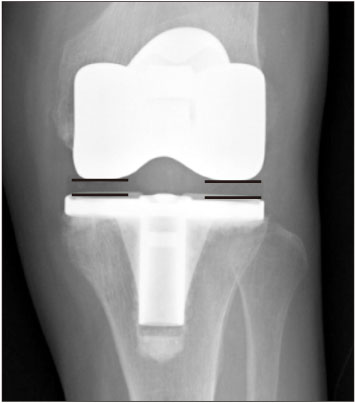J Korean Orthop Assoc.
2018 Jun;53(3):226-233. 10.4055/jkoa.2018.53.3.226.
Eight to Ten Year Follow-Up Results of Total Knee Arthroplasty Using Electromagnetic Navigation System
- Affiliations
-
- 1Department of Orthopedic Surgery, Pusan National University Hospital, Pusan National University School of Medicine, Busan, Korea. rheefury@naver.com
- 2Department of Orthopedic Surgery, Bumin Hospital Haeundae, Busan, Korea.
- 3Department of Diagnostic Radiology, Pusan National University Yangsan Hospital, Yangsan, Korea.
- KMID: 2429170
- DOI: http://doi.org/10.4055/jkoa.2018.53.3.226
Abstract
- PURPOSE
The purpose of this study was to compare the clinical and radiological results between patients who underwent total knee arthroplasty using the conventional method and the navigation-assisted method.
MATERIALS AND METHODS
A retrospective review of was performed on 32 patients (40 knees) who underwent total knee arthroplasty between February 2004 and December 2006 and were followed-up for 8 to 10 years. Mechanical axis deviation, range of motion, radiologic position of the implants, and subjective clinical scores were measured and compared between 20 navigation-assisted total knee arthroplasties and 20 conventional total knee arthoplasties. Change in the values (α, β, γ, and δ angles) from the immediate postoperative period to the last follow-up were also calculated and compared between the two groups.
RESULTS
The mean range of motion in the navigation group was improved to 121.8°±16.3° (92°-140°) at the last follow-up, and the Western Ontario McMaster Universities osteoarthritis Index (WOMAC) score was 89.8±5.4 and the Knee Society score (KSS) was 91.5±7.5. The mean range of motion in the conventional group was 112.6°±25.6° (60°-140°) at the last follow-up. The WOMAC score was 84.2±10.6, and the KSS was 81.1±14.3. The α, β, γ, and δ angles of the implants were not significantly changed until the last follow-up. In the comparison between the two groups, only the mean range of motion (p=0.018) and the KSS (p=0.038) showed statistically better results in the navigation group than the conventional group.
CONCLUSION
Navigation-assisted total knee arthroplasty showed better KSS and range of motion compared with the conventional group in a cross-sectional study with 8 to 10 years of follow-up results. However, only the KSS showed a significant difference between the two groups by the amount of changes in the clinical and radiological results.
Keyword
MeSH Terms
Figure
Reference
-
1. Hamilton DF, Howie CR, Burnett R, Simpson AH, Patton JT. Dealing with the predicted increase in demand for revision total knee arthroplasty: challenges, risks and opportunities. Bone Joint J. 2015; 97:723–728.2. Andriacchi TP. Biomechanics and gait analysis in total knee replacement. Orthop Rev. 1988; 17:470–473.3. Bai B, Baez J, Testa N, Kummer FJ. Effect of posterior cut angle on tibial component loading. J Arthroplasty. 2000; 15:916–920.
Article4. Laskin RS. Total knee arthroplasty using an uncemented, polyethylene tibial implant. A seven-year follow-up study. Clin Orthop Relat Res. 1993; 288:270–276.
Article5. Matsuda S, Miura H, Nagamine R, et al. Posterior tibial slope in the normal and varus knee. Am J Knee Surg. 1999; 12:165–168.6. Mihalko WM, Krackow KA. Posterior cruciate ligament effects on the flexion space in total knee arthroplasty. Clin Orthop Relat Res. 1999; 360:243–250.
Article7. Bäthis H, Perlick L, Tingart M, Lüring C, Zurakowski D, Grifka J. Alignment in total knee arthroplasty. A comparison of computer-assisted surgery with the conventional technique. J Bone Joint Surg Br. 2004; 86:682–687.8. Anderson KC, Buehler KC, Markel DC. Computer assisted navigation in total knee arthroplasty: comparison with conventional methods. J Arthroplasty. 2005; 20:S132–S138.9. Clemens U, Miehlke RK. Experience using the latest Ortho-Pilot TKA software: a comparative study. Surg Technol Int. 2003; 11:265–273.10. Matsumoto T, Muratsu H, Tsumura N, et al. Joint gap kinematics in posterior-stabilized total knee arthroplasty measured by a new tensor with the navigation system. J Biomech Eng. 2006; 128:867–871.
Article11. Ewald FC. The Knee Society total knee arthroplasty roentgenographic evaluation and scoring system. Clin Orthop Relat Res. 1989; 248:9–12.
Article12. Stulberg SD, Yaffe MA, Koo SS. Computer-assisted surgery versus manual total knee arthroplasty: a case-controlled study. J Bone Joint Surg Am. 2006; 88:Suppl 4. 47–54.
Article13. Saragaglia D, Picard F, Chaussard C, Montbarbon E, Leitner F, Cinquin P. Computer-assisted knee arthroplasty: comparison with a conventional procedure. Results of 50 cases in a prospective randomized study. Rev Chir Orthop Reparatrice Appar Mot. 2001; 87:18–28.14. Seon JK, Song EK. Navigation-assisted less invasive total knee arthroplasty compared with conventional total knee arthroplasty: a randomized prospective trial. J Arthroplasty. 2006; 21:777–782.15. Decking R, Markmann Y, Fuchs J, Puhl W, Scharf HP. Leg axis after computer-navigated total knee arthroplasty: a prospective randomized trial comparing computer-navigated and manual implantation. J Arthroplasty. 2005; 20:282–288.16. Choong PF, Dowsey MM, Stoney JD. Does accurate anatomical alignment result in better function and quality of life? Comparing conventional and computer-assisted total knee arthroplasty. J Arthroplasty. 2009; 24:560–569.
Article17. Ishida K, Matsumoto T, Tsumura N, et al. Mid-term outcomes of computer-assisted total knee arthroplasty. Knee Surg Sports Traumatol Arthrosc. 2011; 19:1107–1112.
Article18. Kamat YD, Aurakzai KM, Adhikari AR, Matthews D, Kalairajah Y, Field RE. Does computer navigation in total knee arthroplasty improve patient outcome at midterm follow-up? Int Orthop. 2009; 33:1567–1570.
Article19. Kim YH, Park JW, Kim JS. The clinical outcome of computer-navigated compared with conventional knee arthroplasty in the same patients: a prospective, randomized, double-blind, long-term study. J Bone Joint Surg Am. 2017; 99:989–996.
- Full Text Links
- Actions
-
Cited
- CITED
-
- Close
- Share
- Similar articles
-
- Comparison of Precision between Optical and Electromagnetic Navigation Systems in Total Knee Arthroplasty
- Early Results of TKA with Electromagnetic Navigation
- Comparison of Mobile-Bearing and Fixed-Bearing Designs in High Flexion Total Knee Arthroplasty: Using a Navigation System
- Radiological Results and Assessment of Navigation-Guided Total Knee Arthroplasty
- Comparison of Results of Total Knee Arthroplasty Performed Using the Navigation System and the Conventional Technique: Minimal Follow-Up of 5 Years


